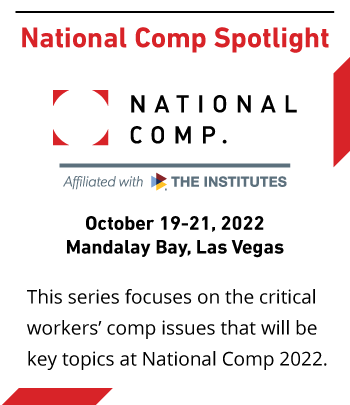Are These Legal and Regulatory Trends on Your Radar?

The workers’ compensation environment is constantly evolving to meet the needs and changes occurring throughout the workplace.
 Keeping up with regulatory and legislative issues poses a significant challenge for workers’ compensation professionals because of how frequently regulations change and differ from state-to-state. Oftentimes, changes in one area of the law impact other areas and monitoring what the changes are and evaluating how they impact one’s business can be difficult.
Keeping up with regulatory and legislative issues poses a significant challenge for workers’ compensation professionals because of how frequently regulations change and differ from state-to-state. Oftentimes, changes in one area of the law impact other areas and monitoring what the changes are and evaluating how they impact one’s business can be difficult.
Highlighting key must-know legal and regulatory trends is a top priority for the National Comp conference, and a core topic on our program agenda for 2022.
Four experts will come together to present “Workers’ Compensation Regulatory Trends You Need to Know Heading Into 2023″ on Oct. 19th. These thought leaders spoke with R&I in advance of the presentation to talk about what’s on the radar right now.
Workers’ Comp Legal Trends To Watch
Sharing their insights with National Comp are Brian Allen, vice president of government affairs at Mitchell Casualty Solutions; Michele Hibbert, senior vice president, regulatory compliance at Mitchell; Ben Roberts, vice president of utilization review at Genex Services; and Lisa Anne Bickford, director of government relations at Coventry.
“For most states, COVID shifted the focus away from planned legislative and regulatory agendas and, in many jurisdictions, paused the majority of legislative and regulatory activity that wasn’t directly associated with the pandemic,” Roberts said. “As we continue to come out of the pandemic, many states will look to catch up on the issues they weren’t able to address over the last two years.”
Here are some of the key trends these experts are watching.
1. Fall Elections
The mid-term elections will have a significant impact on legislative initiatives in the workers’ comp industry.
“Over the past few elections, we’ve seen an influx of newcomers winning seats. This changeover is due, in part, to retirements of veteran congresspeople coupled with term limits,” Lisa Anne Bickford said. “The ‘Great Resignation’ has also impacted lawmakers as we’re seeing more move on from their congressional posts to accept positions in the private sector.”
Brian Allen added that we’ll also likely see the House majority flip Republication in November – perhaps as much as 25 percent.
Changing legislative personnel can result in significant policy shifts and, as Bickford mentioned, an influx of freshman legislators means there’s going to be a new group of lawmakers who likely have limited knowledge of workers’ comp.
“This poses a challenge and also a unique opportunity for those of us in the industry as these lawmakers will need to be educated and we can have a substantial influence,” Allen said.
2. Drug Price/PBM Transparency
A major initiative on the federal level is to improve transparency on drug pricing and pharmacy benefit management organization operations. As Allen pointed out, the Federal Trade Commission has recently launched an inquiry into the top six largest PBMs to investigate the influence these groups have over the pricing and access of U.S. prescription drugs.
3. Medicare: OPPS, IPPS, Physician Fee Schedule, Telehealth
Medicare-related fee schedule changes (OPPS, IPS, Physician Fee Schedule, ASC Covered Procedures List) will likely roll down to states that have adopted Medicare as their reimbursement base (and some states even adopt Medicare payment policies, such as Texas).
“Furthermore, with the impending expiration of COVID-related emergency telemedicine rules, Congress is looking at various ways to expand the availability of telehealth services once the Public Health Emergency is deemed to end (currently slated for October),” Bickford said. “Federal policy dictates which telemed services are reimbursable for Medicare, which then may ‘roll down’ to CMS-based states for workers’ comp.”
4. Medical Marijuana
Legalization and “decriminalization” of marijuana have been at the forefront of several legislative initiatives for both medicinal and recreational use, including the “MORE” Act, which passed the House in April of 2022.
“Proponents of the SAFE Banking Act seek to harmonize federal and state law by prohibiting federal regulators from taking punitive measures against depository companies that provide banking services to legitimate cannabis-related businesses that serve them,” Allen said.
5. Department of Labor Potential Oversight/Analysis of State Workers’ Comp Programs
This is a movement in which federal legislators are seeking initiatives to ensure all states are providing adequate and more uniform standards of workers’ comp services and offerings. This includes increased federal oversight and tracking of states to ensure they’re meeting those standards.
6. The U.S. Economy
The U.S. economy’s market performance will continue to have a direct influence on workers’ comp. Bickford stressed that this will likely manifest in claim volume fluctuations. Also, the current rise of inflation will likely drive fee schedule costs.
“On the labor side, increasing numbers of employees working from home will impact workers’ compensation claims as this shifting workforce drives new challenges for the industry,” Bickford said.
State Trends
As mentioned previously, many state legislative and regulatory trends are impacted by what’s being done or considered on the federal level. Also, since workers’ comp laws can vary significantly by state, here are some of the top trends that will be tackled during the National Comp Spotlight session in October:
- Air ambulance issues: Applicability of the Federal Airline Deregulation Act and recent case law
- Medical marijuana decisions and legislative initiatives
- Drug transparency issues
- Networks and direction of care
- Presumption law activity
- Auto physical damage-with a focus on recent Michigan initiatives
- Potential reform discussions: this includes California, Texas sunset review, and potential impacts in the various states if the federal 1972 Report of the National Commission on State Workmen’s Compensation Laws is used to benchmark the performance of modern workers’ compensation state systems
“I’d encourage professionals to get involved with their state and national trade associations and be vocal,” Hibbert said. “It’s true that the squeaky wheel often gets the grease in politics, and this is especially true with more freshman legislators entering Congress and state legislatures. It’s a great time to be an influencer and advocate for workers’ comp.” &
Hear more from these and other workers’ comp industry leaders at National Comp 2022 at Mandalay Bay in Las Vegas, Oct. 19-21.











